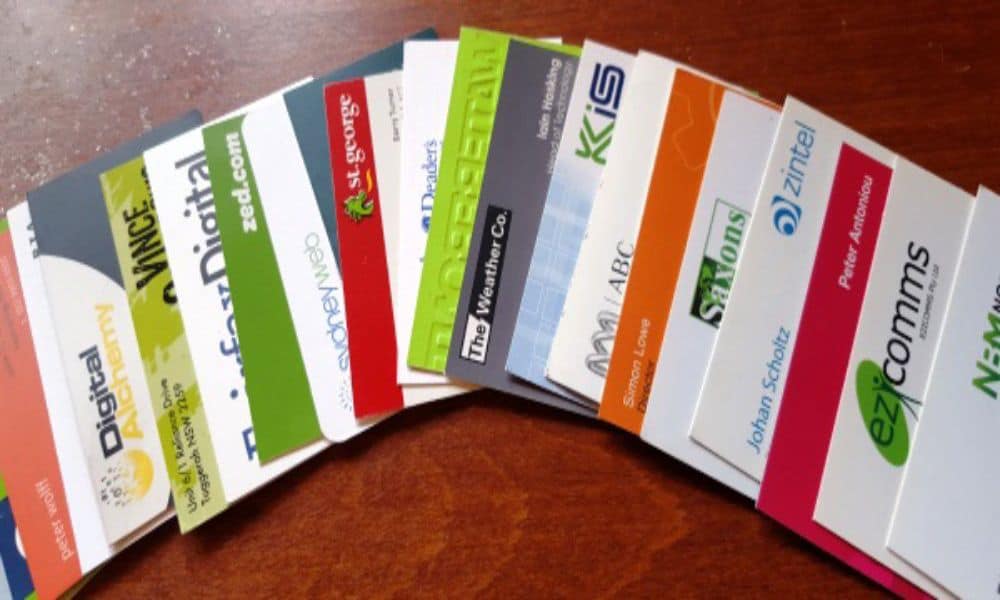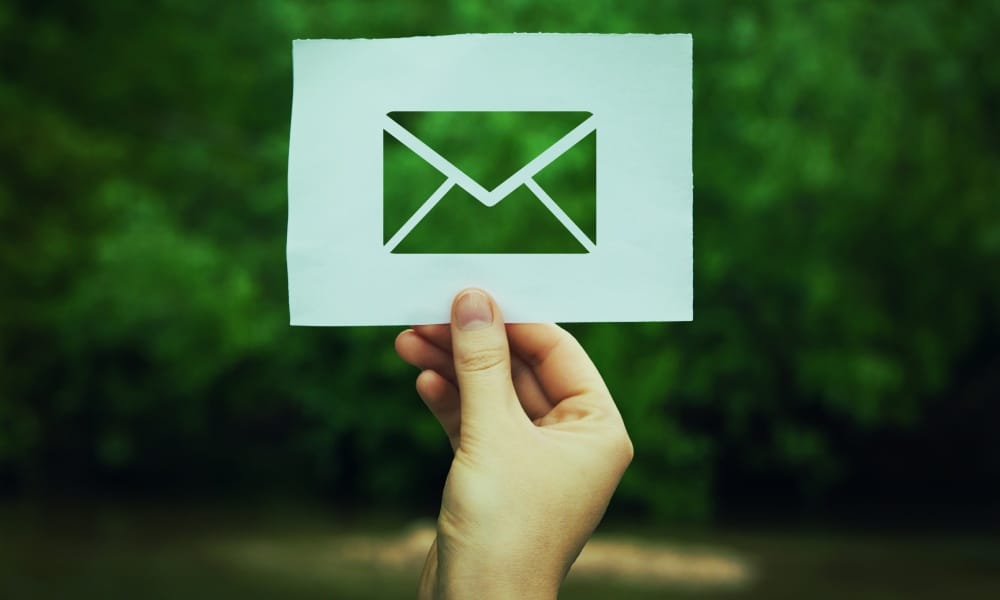I’ve posted before about writing for the web, but today I’d like to look at writing email copy specifically.
Blog content is often repurposed for email – and at NoBull Marketing we support that as an excellent way to get more bang for your content buck. But just slapping the exact same words into an email isn’t the best way to maximise results.
Why? Here are 7 ways that email copy and writing for the web are different. Read on, or jump to the point which interests you the most.
- Your audience is different
- You have to consider spam filters rather than SEO
- Email copy is more likely to be ‘disposable’
- Email lets you control the order in which people see things
- Layout and formatting are different
- Subject lines and post titles work differently
- Emails are a great way to test changes in your offer
1. Your audience is different
Anyone can visit your website. They might know nothing about you. So what you write on the web has to work for strangers. But anyone who’s on your email list knows you, at least a little bit. They chose to sign up, after all.
You also control who gets which emails. Segmenting your list is one option, if you get enough data about your contacts. Or you can have multiple lists for different kinds of email (we have the monthly update, events and special offers). You can also select individuals based on specific characteristics. Depending on the sophistication of your technology setup and the quality of your data, this could be people who have:
- visited certain pages
- downloaded specific resources
- bought something from you
- not bought anything from you
So what does this mean for your email copy?
You have some kind of relationship with people on your email list. Email is an opportunity to be a little more intimate and develop that relationship. Use it!
- Let more of your personality show. Let small facts in, or even tell personal stories. (When I shared some lessons learned from personal events, I got three times the usual number of replies.)
- Personalise!
Maybe the only information you have is a first name? Use it. Greet people by name. Try to find a way to use it in the main copy too. Maybe not every time, but sometimes.
If you have other information like the business name or industry, this can be really helpful too. Of course you need to be smart about default values if you don’t have full details for everyone on your list, but a little creativity goes a long way.
2. You have to consider spam filters rather than SEO
This can change the details of how you write.
Email copy doesn’t need a ‘focus keyword’ in the way web copy does. But you do need to be careful about triggering spam filters, or your message won’t reach people at all.
3. Email copy is more likely to be ‘disposable’
Blog articles and most pages on your website will stay there for some time. Months, even years. Sure, there are exceptions like pages promoting an event, but the general rule is you want evergreen content which stays relevant.
Your email, on the other hand, has a very short life. Research shows that over half of the people who are going to open it will do so within 7 hours. Around three quarters of them will open it within 24 hours.
What this means is that you can reference topical events and culture without worrying about how long they’ll stay top of mind. Remember the Netflix series Tiger King? Here’s what fashion retailer Shinesty did with that:

(image courtesy of Sleeknote)
Even if you’re repurposing blog content to include in emails, there may be cases where you can slip in a topical joke. It doesn’t have to be the whole email.
4. Email lets you control the order in which people see things
You probably have some ideas about which pages on your website you’d like people to visit first. You may even have call-to-action options set up so they can follow the path you want them to. But the sad truth is, many of them won’t. They’ll hop around all over the place, looking at what they want to.
Automated email sequences (nurtures) work in a very different way. You control which content you share and when you share it.
Let’s imagine for a moment that NoBull Marketing has done some industry research on the effectiveness of marketing for small to medium law firms. You run a practice with 5 lawyers and you download it to learn more. Naturally, the first thing we send you is the report, but after that, we can ‘lead’ the email conversation in the direction we want.
- The follow up email talks about an issue noted in the report. It’s something we can help with (no website visibility), but we don’t sell it at this stage. We just draw your attention to this as a common issue for you and your competitors.
- A few days later, we send you another follow up email, and now we mention that this is something we have helped with and which has helped our client XYZ company. (“When we were selling the business, the consultant advised that the best thing the new owner could do for visibility is to continue blogging regularly.“)
- In the next email, we give you some detail of how our service works and ask you whether it would fit your model.
You can see how this content matches the buyer journey:
- awareness of a problem
- interest in possible solutions
- research into how solutions might work and what they could cost
As you can see from the flow below, you can even send different followup emails depending on how people interact with the first one. This kind of sequencing makes email very powerful and is a key driver of ROI in email marketing.
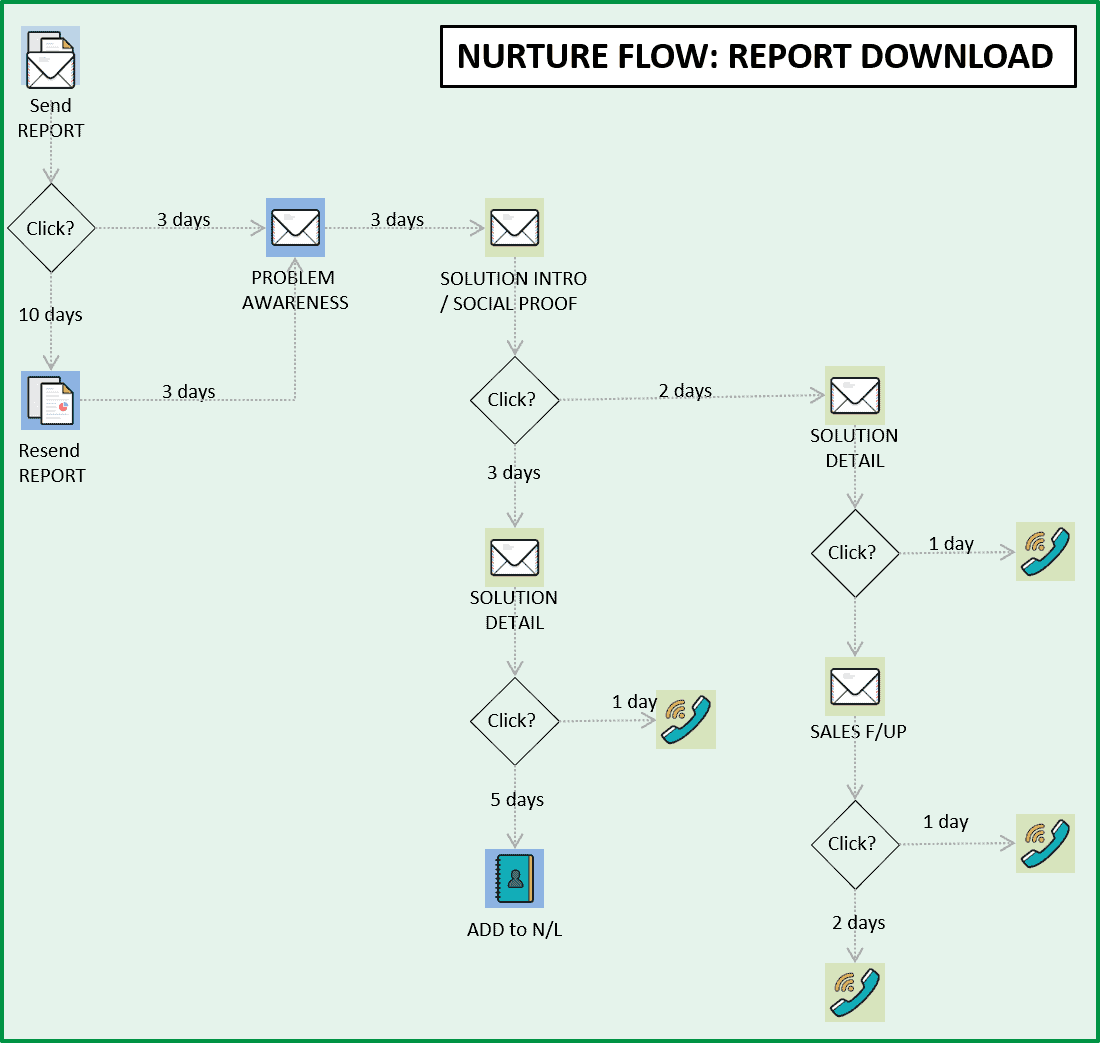
It’s worth noting too that you can control the amount of information you share in each email. You can keep to bite sized pieces of information. Or you can include a key point in the email along with a link to the main article on your website. This gives you the ability to track who clicks, and helps you assess levels of interest and know your potential customer better.
5. Layout and formatting are different
Any decent email platform or web content platform has lots of exciting and creative layout options. But while the W3C sets standards for website coding and display, email standards are less centralised. With more variety, there’s a higher risk of something going wrong, or just looking plain weird in certain email inboxes and programs.
Like this:
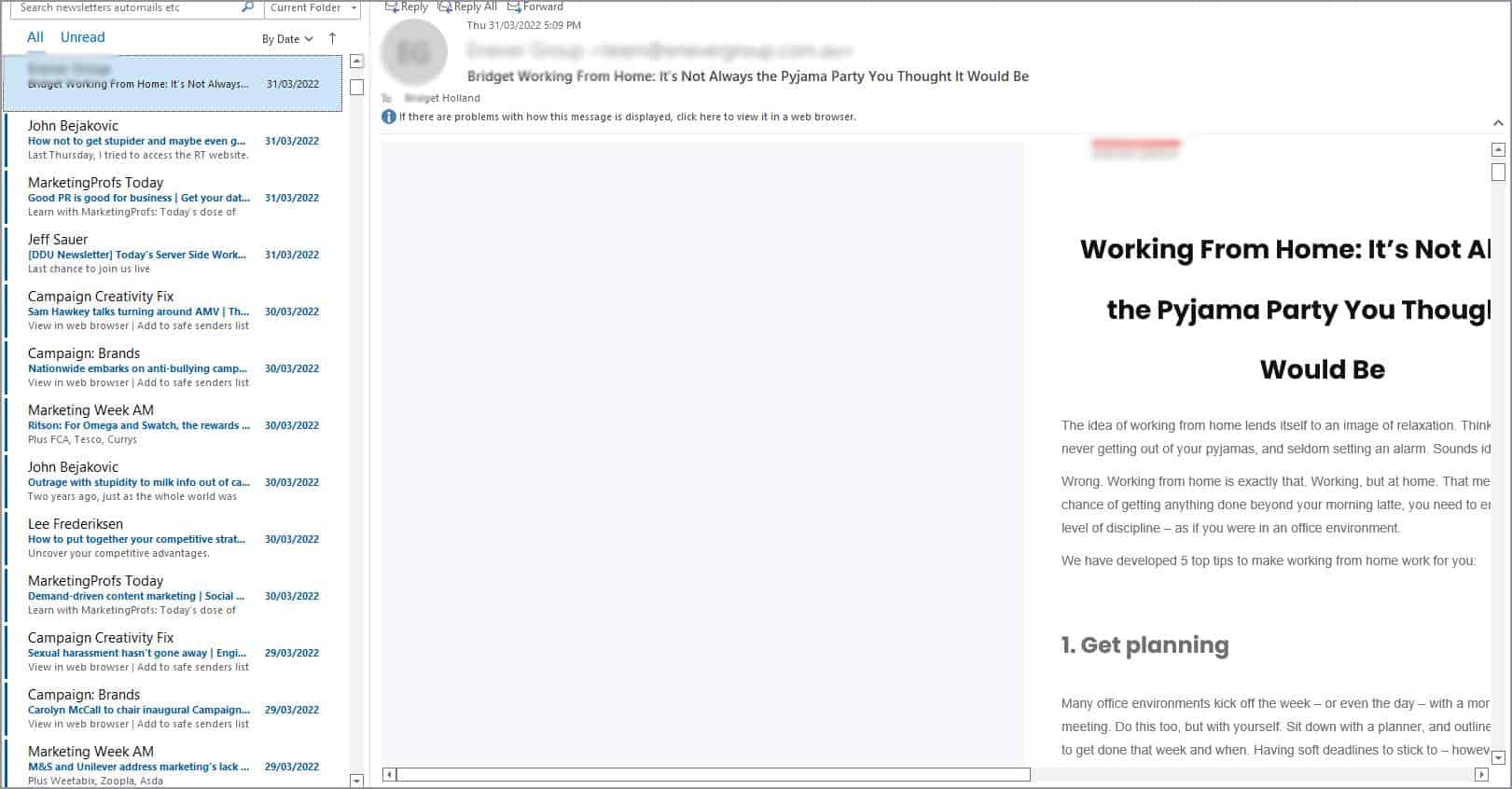
That means the recommendation is to ditch fancy layouts in email and go with one or at most two columns. Remember, a massie amount of email is read on a phone, so it needs to work on a small screen.
There are also some specific things you can include in an email which don’t exist online.
Preview text
The preview text shows up before people click on an email – in some layouts of some email programs. It’s an additional teaser to capture attention and get people to click through and read. Don’t miss it!
The PS
Classic direct marketing research suggests that 90% of people read the PS before they read the entire letter. It’s seen as a way to get to the heart of what your ‘long’ text is all about – even when your text isn’t long! Email works the same way. Adding a PS can help in so many ways:
- repeat your call to action
- create urgency
- add a bonus to increase interest
- show your humanity by sharing something personal
- connect on additional channels like social media
There is no web equivalent of the PS – unless you have a page formatted to read like a letter. But when you’re writing email copy, the PS is powerful. Use it!
6. Subject lines and post titles work differently
5 times as many people read headlines as read the body of an article or email. Email subject lines and post titles both matter, but they work slightly differently.
Post titles are designed not just for readers, but also for Google. They have to work for SEO. That leads to a pretty clear consensus on ‘best practice’:
- You need to include the target keyword (or something close to it), preferably at the start of the headline.
- Your title should be 40-60 characters in total.
- Your title should be 6 or 7 words long.
The good news for blog titles is that if the blog does get onto page one of Google, it’s likely to get some clicks. People are searching, so they have high interest. And there’s only a handful of competitors.
Email subject lines face completely different challenges. Reaching the inbox is easier, but getting a click is harder. Not only is there far more competition, but the reader is not actively interested. Here’s what your email subject line has to contend with:
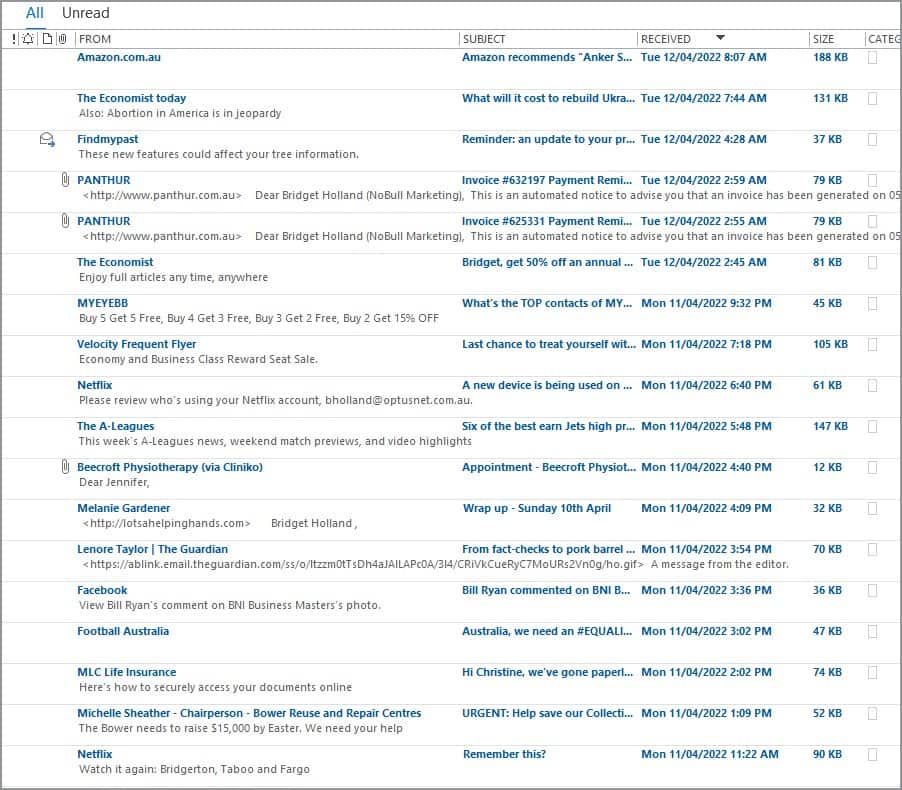
So it’s all about getting you to open the damn email. ‘Best practice’ is harder to define, but boils down to:
- Stand out. Be shorter or longer than average. Emojis or capitalisation are other ways to make your subject line more visible, but they may get you thrown into spam. Use unusual words.
- Give the reader a reason to click. Ask a question. Say there’s a special offer. Promise to share a secret. But just like a movie trailer, don’t give the whole plot away at once.
- Also, you can see the preview text (in grey underneath each ‘From’) working hard to help the subject line. Or not, depending how savvy the sender is.
The good news is that pretty much any email marketing platform allows you to test subject lines. You just need a big enough list to make it worthwhile.
7. Emails are a great way to test changes in your offer
We all know banks offer better deals for new customers than for the ones they’ve got already. You might want to do the same thing. But you might not want to publicise it on your website. (Hint, it’s a good way to annoy existing customers – as you can tell from how much we all love banks!)
Make that special offer in an email, sent to non-customers only. Or non-customers for the particular service you’re promoting. Heck, if you have enough prospects, you can even test uptake on two or more offers. All without messing up your overall marketing or cheapening your brand.
The same principle applies for offering a new service or package. You can test options with relative safety. And if they don’t work, only you will know. Even the people on your email list won’t know whether your campaign was successful overall. They’ll only know what they themselves did.
So, here’s a quick cheatsheet showing the main things you need to think about when comparing email copy and writing for the web.
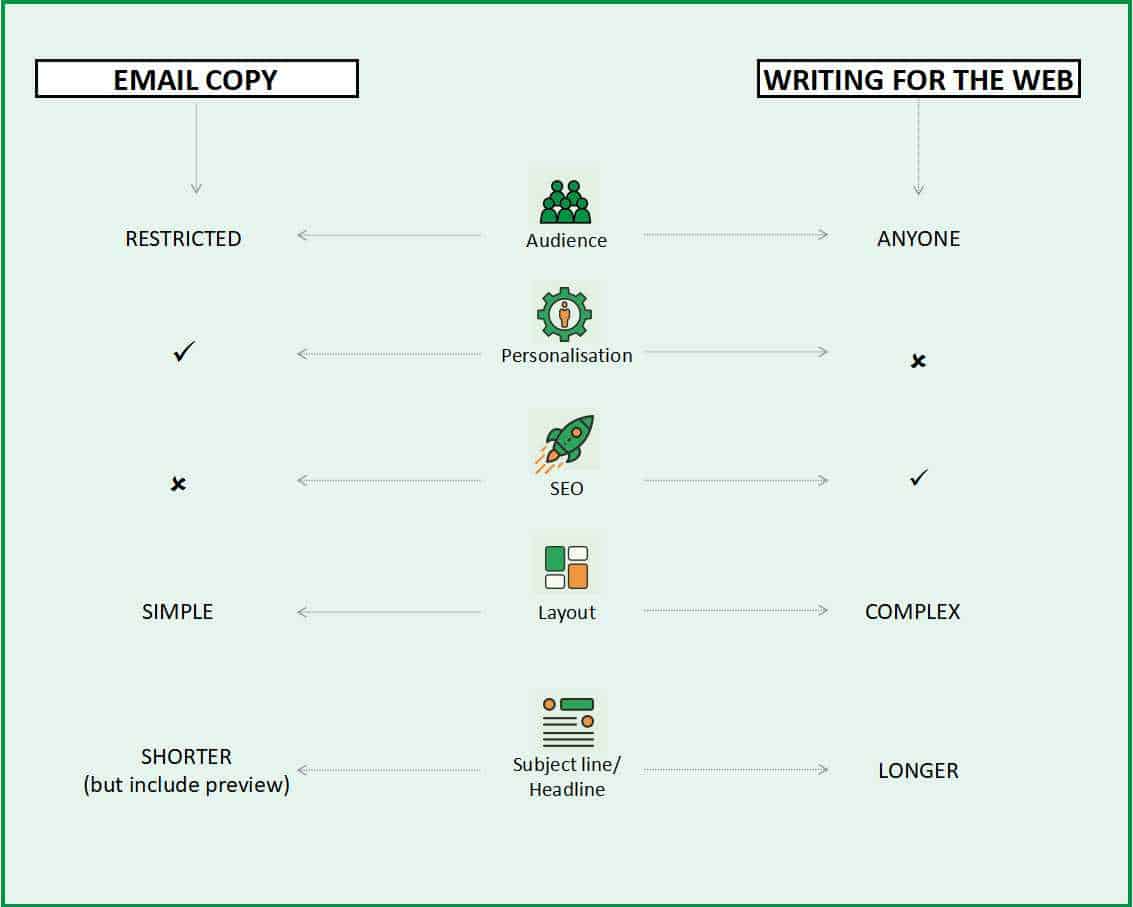
But remember…
Not everything is different
Good email copy and good web copy aren’t exactly the same, but it’s worth finishing up with a reminder of two key similarities:
- Skimmability.
Make it easy on the reader. Short paragraphs. Headings. Bullet points. White space. - Call to Action
This is marketing. You want people to do something. Make it clear what to do next.
So if you want better email copy and better results from your emails, the next step is to get in touch.



